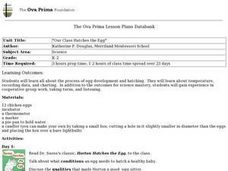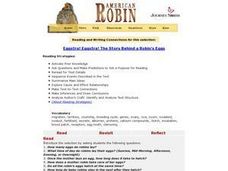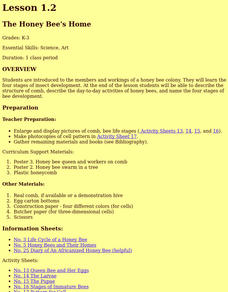Curated OER
Help the Duck Find Her Babies
Students are introduced to a basic characteristic and need of living things-the ability and need to reproduce. They investigate how birds (and people) attract mates. Students discover how to build a nest. They discuss the needs and...
Curated OER
Eighteen Ways to Make a Baby
Students view a video clip about post-menopausal women having children. They identify the ethical, legal and social implications of this. They also read a case study.
Curated OER
Hatched From An Egg
Students discover how animals are born/hatched. In this life science instructional activity, students listen to a book entitled Chickens Aren't The Only Ones, and discuss animals that are hatched or born. Students receive a picture of...
Curated OER
One + One = One
Students develop problem solving skills while developing writing skills. They assume responsibility for a sugar or egg "baby" and journal the experiences. In addition, they create a birth certificate and a holder.
Curated OER
"Our Class Hatches the Egg"
Learners research all about the process of egg development and hatching. They access about temperature, recording data, and charting. In addition to the outcomes for science mastery, students gain experience in cooperative group work,...
Curated OER
Making Babies
Students participate in a genetics activity in which they determine genotypes and phenotypes for given traits. They work with a partner and create babies based on their genotypes. Once traits for babies are determined, they write...
Curated OER
American Robin: Eggstra! Eggstra! The Story Behind a Robin's Eggs
Students answer questions about robin's eggs. They read about robins, then mark up text for unfamiliar words.
Curated OER
Dragon Genetics - Understanding Inheritance
Six pages begin with a detailed introduction to meiosis and homologous chromosome pairs. Instructions guide learners through a simulation in which they draw craft sticks marked with autosomes in order to decode the genes inherited by...
Curated OER
Help the Duck Find Her Babies
Students study the basic need for animals to attract mates and reproduce young.
Curated OER
Making Babies
Sixth graders complete a human traits survey. In this genetics lesson plan students read articles and fill out a worksheet on genotype and phenotypes.
Curated OER
Language Arts/Science: Genetic Diseases Simulation
Eighth graders engage inn role-playing activities as families caring for babies with genetic defects. A partial list of activities include: dressing the babies ( raw eggs), designing birth certificates, and recording a log of care,...
Curated OER
One + One=One
Young scholars discover that learning can be fun. Problem solving skills are developed through various writing skills. Empower students with personal concept development and time management. Document growth and success of the learner....
Curated OER
What Kind of Animal Are You?
With the descriptions of six different animal groups (amphibians, birds, fish, insects, mammals, reptiles), students match different examples of animals to their proper groups (lizard to reptiles, girl to mammals, etc). The activity...
Curated OER
Renewable and Non-renewable Resources
Students play Lobster Bingo on a provided worksheet. This game demonstrates how human activities and natral events affect lobsters by impacting their food, clean water, and shelter of the reef.
Curated OER
Get the Facts
Students explore spiders. In this spider lesson, students fill out KWL charts, discover facts about spiders and how to identify different spiders. Students research spiders on the Internet and do online activities.
Exploring Nature Educational Resources
Building A Classroom Food Web
From bears and owls to chipmunks and trees, all life depends on the sun for the energy to survive. Young biologists develop an understanding of this big idea as they arrange this series of plant and animal picture cards into food webs...
Curated OER
Going Places
In this going places worksheet, students read the passages provided and answer the given questions. Students answer questions as it relates to the skeletal system, puberty, and microorganisms.
Curated OER
Australia
Learners identify animals that are unique to Australia, study their habitation and how they fit in their environment. In this exploratory lesson students research a topic to find out specific information about it.
Curated OER
Sea Turtle Savvy
Students explore sea turtles. They create paper plate sea turtles and brainstorm other organisms that live in the sea turtle's habitat. They role-play scenes from a nonfiction book, A Baby Sea Turtle's Journey. They play a game...
Curated OER
Baby Animals
Students study baby penguins and whales. They name the penguin body parts and examine how penguins hatch from eggs. They name whale body parts and their function. They participate in a whale role play activity.
Curated OER
Chemical Changes
Second graders investigate chemical changes and reactions and will identify four characteristics that indicate a chemical change. In this chemical change lesson plan, 2nd graders perform experiments that promote chemical changes. They...
Curated OER
In My Backyard
In this backyard wildlife activity, students read and complete activities on 6 pages. Students make a mini book to read that pertains to common backyard wildlife. Students read about signs of animal life and learn about wildlife...
Curated OER
The Honey Bee's Home
Learners are introduced to the members and workings of a honey bee colony. They describe the structure of a comb, the day-to-day activities of honey bees, and name the four stages of bee development. They construct a honeycomb model.
Curated OER
Scientific Classification
In this scientific classification worksheet, students read about classification and the questions scientists ask in order to classify, then read about features of different classifications of animals. Worksheet is informational, no...

























